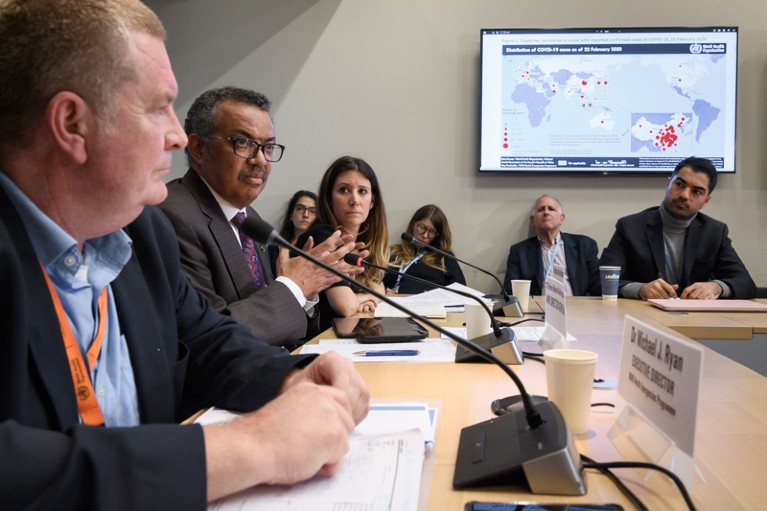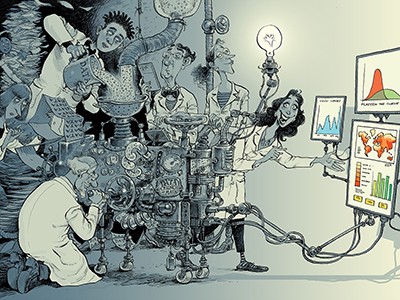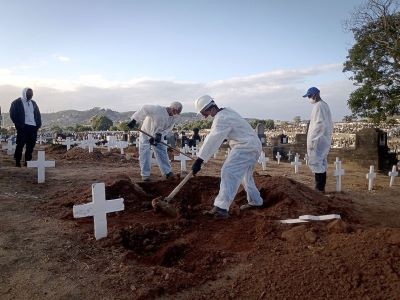
The WHO’s COVID technical lead, Maria Van Kerkhove (middle), says it’s crucial that surveillance systems “are not taken apart”.Credit: Fabrice Coffrini/AFP/Getty
From the way political leaders in many high-income nations are talking and acting, it would be easy to think that the COVID-19 pandemic is no longer worth keeping track of.
The pandemic might have taken upwards of 18 million lives, disabled many more than that and gut-punched the global economy, yet surveillance and reporting of the virus’s movements are starting to slow just at a time when a highly infectious subvariant of Omicron, BA.2, is spilling out across the world and case rates and hospitalizations are creeping back up.
These cutbacks are not based on evidence. They are political, and they could have disastrous consequences for the world. Maria Van Kerkhove, technical lead for COVID-19 at the World Health Organization (WHO), says it’s crucial that “the systems that have been put in place for surveillance, for testing, for sequencing right now be reinforced, that they are not taken apart”.
Lessons from the COVID data wizards
Around the world, the frequency of national reporting has slipped below five days a week for the first time since the early months of the pandemic, according to the publishers of the website Our World in Data. In the United States, the Centers for Disease Control and Prevention (CDC) is still reporting nationwide data, but there’s less real-time reporting of death and infection figures at the local level. All but eight states have scaled back to reporting data five or fewer days per week. Florida announced last week that it will now be reporting only fortnightly.
The UK government’s COVID-19 tracking dashboard, one of the world’s most comprehensive, is stopping its weekend updates of infections, mortality, hospitalizations and vaccinations, lumping Saturday and Sunday figures into Monday’s. Prime Minister Boris Johnson says this is part of plans to “live with COVID”.
The downward trend in reporting is subtle, but it mirrors other signs of complacency about COVID-19. The United Kingdom, for example, will no longer provide diagnostic tests free of cost. Several of its data-collection programmes are also ending. REACT-1, a long-running random-testing study, will lose its government funding at the end of this month. And ZOE, a mobile app that residents can use to log their COVID-19 symptoms, has lost its public funding, too. Both have been invaluable to research and policy.
The United States and United Kingdom aren’t alone. In many countries, political sentiments are shifting towards adopting a ‘new normal’. Of course, national budgets are being stretched thin as governments look to increase public expenditure on subsidizing fuel and food as the world plunges from dealing with the pandemic to tackling the global impacts of war in Ukraine. But scaling back virus surveillance at this time is short-sighted. It’s like stopping a course of antibiotics at the first sign of symptoms easing: it increases the risk that the infection will roar back. A study published last week says the next variant could well be more dangerous than those circulating now (P. V. Markov et al. Nature Rev. Microbiol. https://doi.org/hk3q; 2022).
COVID’s true death toll: much higher than official records
Public-health decisions need to be informed by the best available data. Cutting the ability to track and respond to the virus while most of the world remains unvaccinated makes these decisions less reliable. It will also reduce people’s ability make decisions about their own safety.
This is all the more infuriating given that roll-backs of public-health interventions have often come with messages that people should now decide for themselves what measures to take. The CDC, for example, recommends that people at risk of serious complications from COVID-19 “talk to their healthcare provider” about whether they should wear a mask or respirator during “medium” community transmission levels — just when data on transmission are becoming less accessible.
Researchers have worked hard to make disparate sources of data about the pandemic available to the public through several celebrated dashboards. Tools such as the WHO Coronavirus (COVID-19) Dashboard, Our World in Data and Johns Hopkins University’s COVID-19 Dashboard have empowered governments, businesses and individuals to use the best available evidence to make decisions. By reducing the data streams that power these dashboards, governments are shutting their eyes to the danger. If this trend continues, the new normal is going to look a lot like the false comfort of ignorance.

 Lessons from the COVID data wizards
Lessons from the COVID data wizards
 COVID’s true death toll: much higher than official records
COVID’s true death toll: much higher than official records
 Antigenic evolution will lead to new SARS-CoV-2 variants with unpredictable severity
Antigenic evolution will lead to new SARS-CoV-2 variants with unpredictable severity
 Count the cost of disability caused by COVID-19
Count the cost of disability caused by COVID-19




